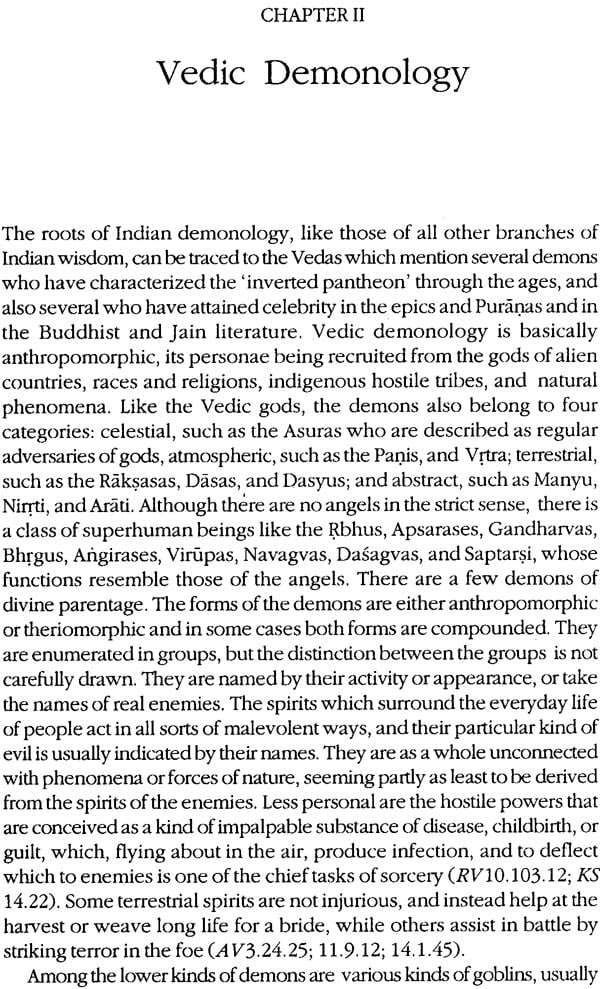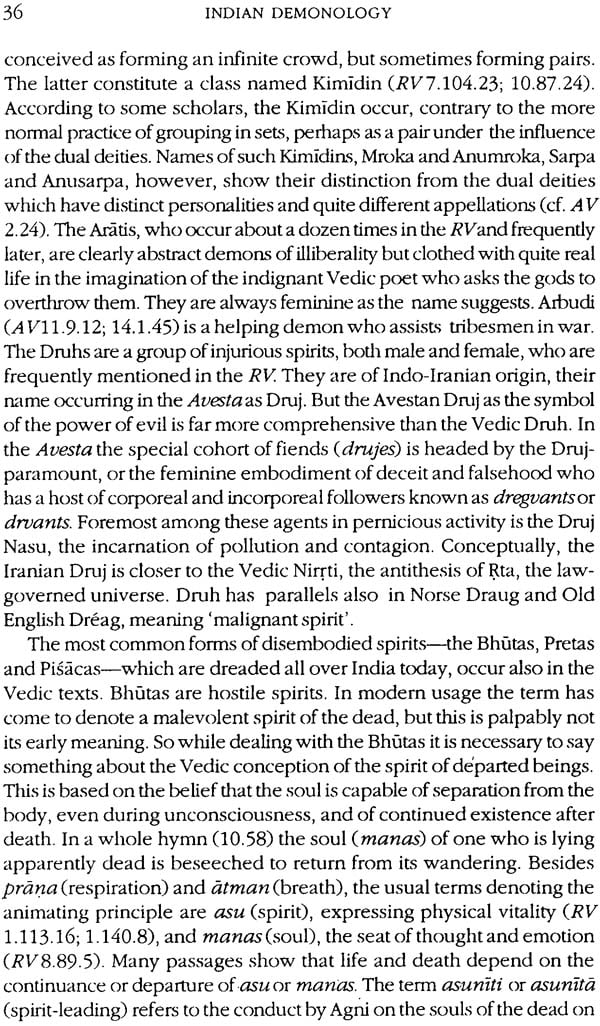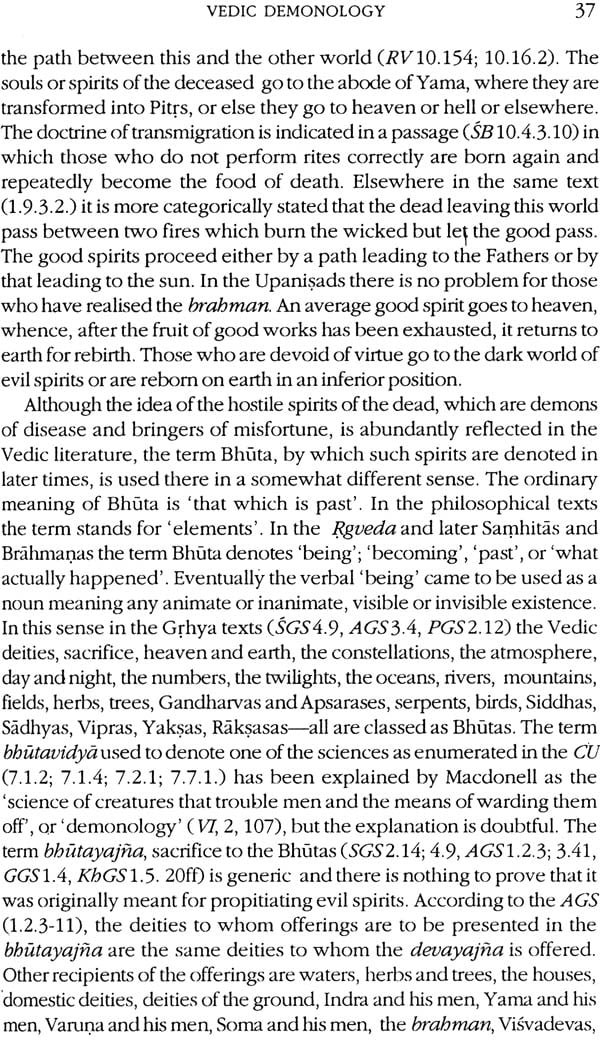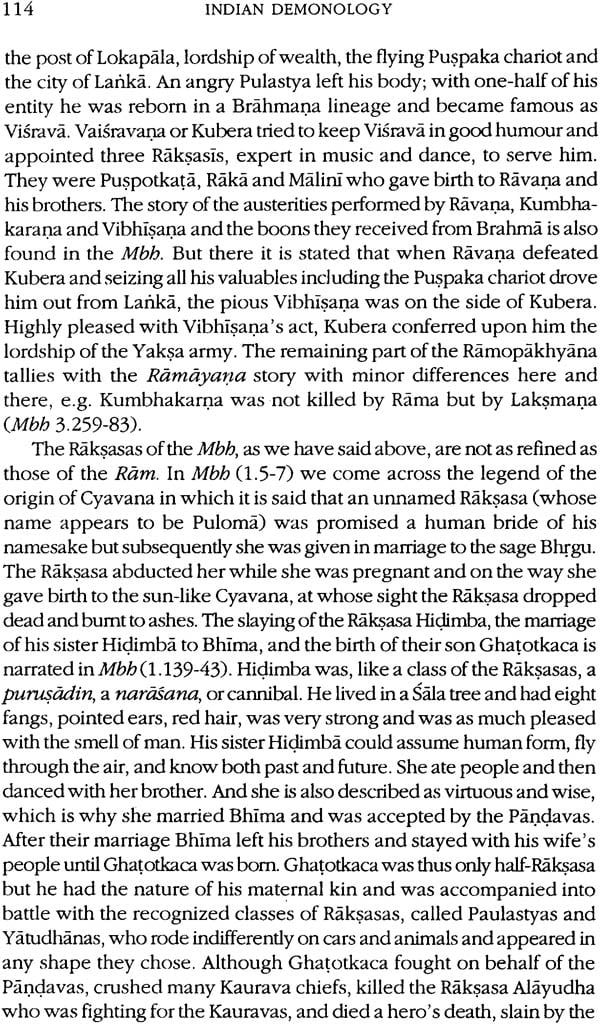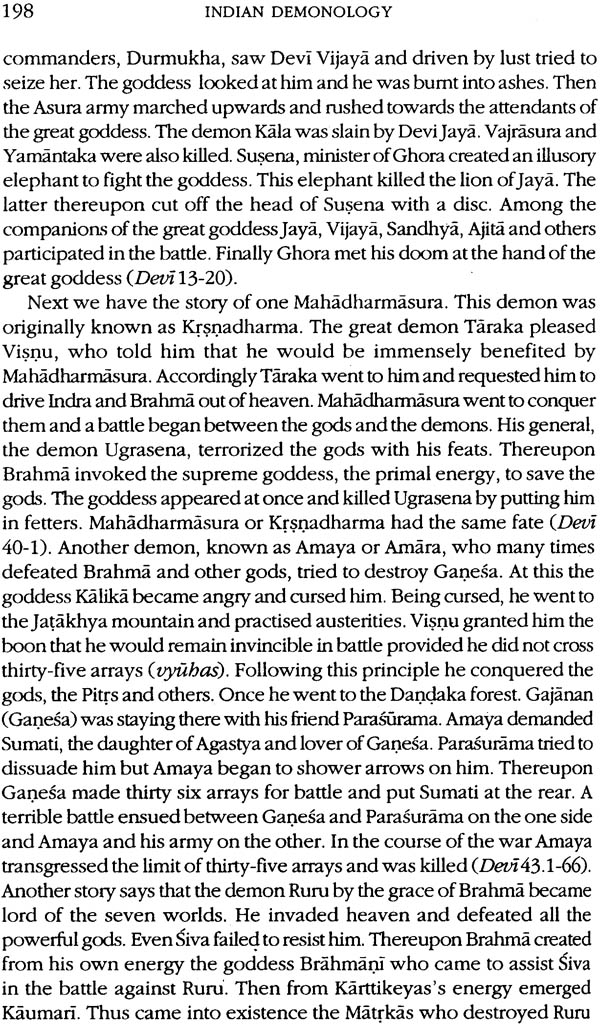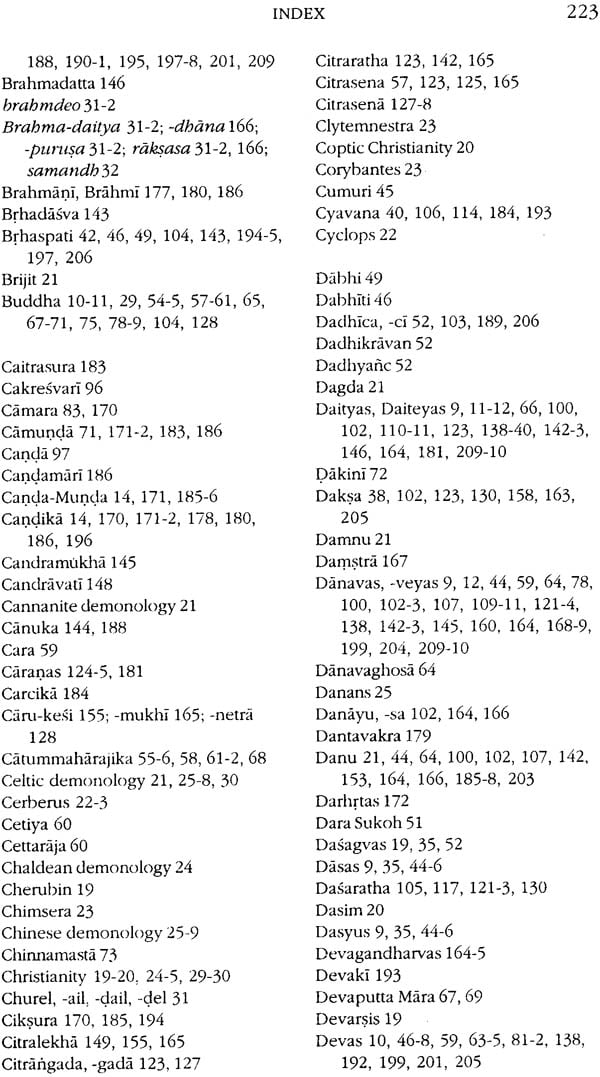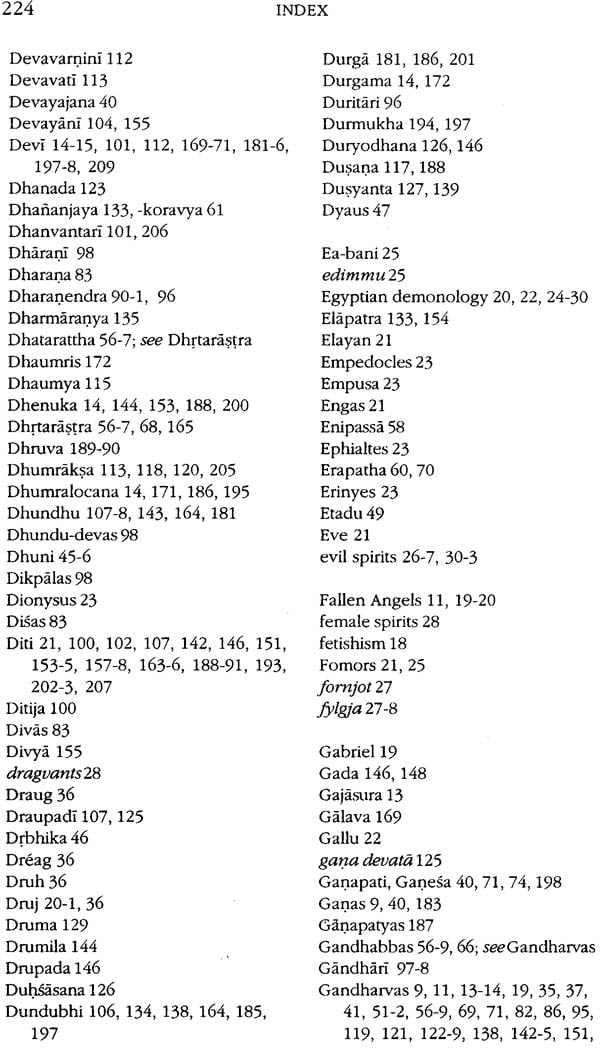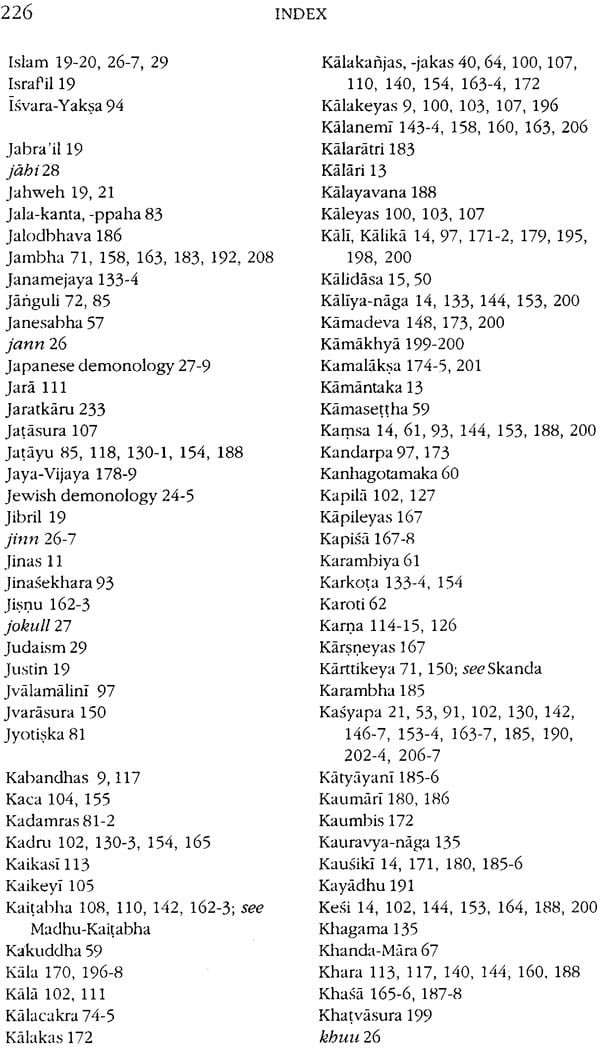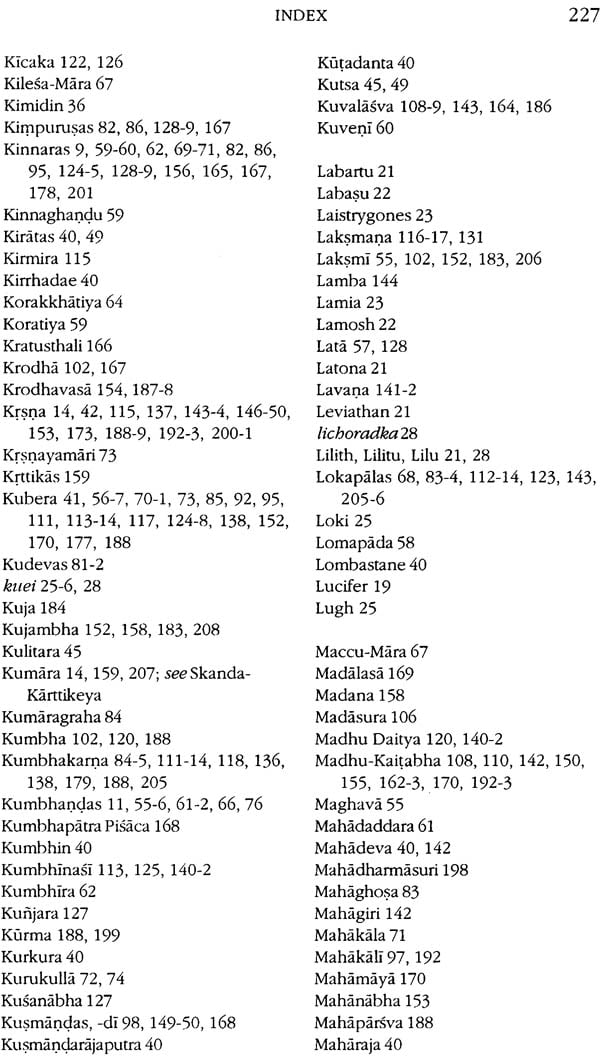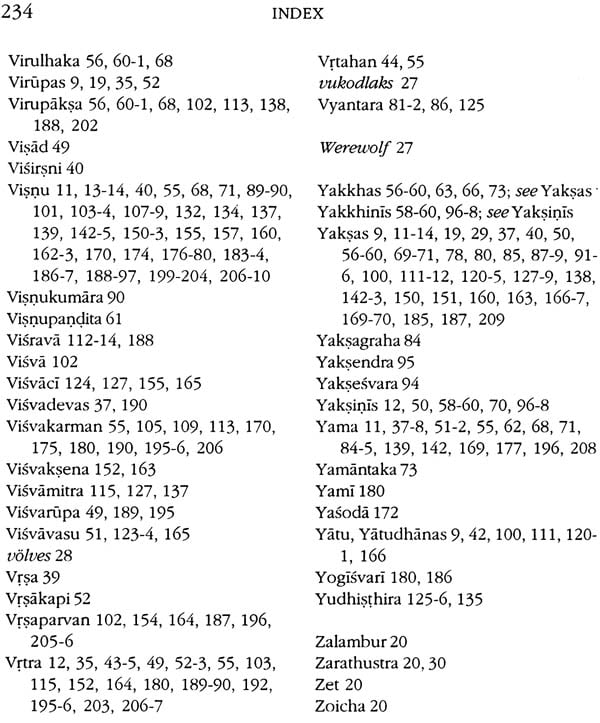
Indian Demonology The Inverted Pantheon
Book Specification
| Item Code: | IDC921 |
| Author: | N. N. Bhattacharyya |
| Publisher: | Manohar Publishers and Distributors |
| Language: | English |
| Edition: | 2020 |
| ISBN: | 9788173043093 |
| Pages: | 234 With Numerous Diagrams |
| Cover: | Hardcover |
| Other Details | 9" x 5.8" |
| Weight | 430 gm |
Book Description
From the Jacket
This is for the first time that Indian demonology and demon-lores, as found in the Vedic. Buddhist , Jain, Epic and Puranic sources have been presented in their entirety on the basis of original materials by N. N. Bhattacharyya who does not require any special introduction to the scholars. The present volume deals at length with the myths and legends pertaining to various kind of celestial, aerial and terrestrial demonical being such as the Asuras, Daityas, Danavas, Raksasas, yatudhanas, Dasas, Dasyus, Panis, Kalakeyas, Vidyadharas, Gandharvas, Yaksas, Apsarases,Rbhus Bhrgus, Angirases, Virupas, Garudas, Suparnas, Kiannaras, Nagas, Pannages,Kabandhas, Bhutas, Pretas, Pisacas,Pitrs, etc., as also various mythical apes, beasts, birds and reptiles, the Pramathas, Ganas, etc., of Siva, the blood-consuming matrkas and so forth and demonstrate how they have been subjected under diverse historical conditions to the processes of social, religious and cultural transformation and why the Indian demonology should be characterized as the 'inverted pantheon'. Like other works of Prof. Bhattacharyya, this one is also expected to evoke great interest among scholars, researchers and readers.
About the Author
Narendra Nath Bhatttacharyya does not require any special introduction in the field of indological studies. Through religious history in his forte he works at ease in diverse branches of ancient Indian history and civilization.
His important publication in English include Indian Puberty Rites, Indian Mother Goddess. History of Indian Cosmogonical ideas, Ancient Indian Rituals and their Social Contents, History of Indian Erotic Literature, Jain Philosophy: Historical outline, History of Researches on Indian Buddhism, History of Tantric Religion, A Glossary of Indian Religion Terms and Concept. Geographical Dictionary of Ancient and Early Medieval India, Ancient Indian History and Civiligation: Trends and Prespectives, Buddism in the History of Indian Ideas, History of the sakta Religion, A Glossary of Indian Religious Terms and Concept, and Indian Religious Historiography.
He was edited R. P. Chanda's Indo-Aryan Races and N. C. Bandyopadhyay's Development of Hindu Polity and Political Theories. He has also edited Medieval Bhakti Movement in India, Jainism and Prakrit in Ancient and Medieval India, and Encyclopaedia of Ancient Indian Culture.
A retired professor of Calcutta University Dr. Bhattacharyya presided over the Ancient India section of the Indian History Congress in 1992.
Preface
The present volume deals at length with the myths and legends pertaining to various kids of celestial, aerial and terrestrial demons and demoniacal beings: Asuras, Danavas, Daityas, Raksasas, Yatudhanas, Dasas, Dasyus, Panis, Kalakeys, Gandharvas, Yaksas, Apsarases, Rbhus, Bhrgus, Angirases, Virupas, Garudas, Suparnas, Kinnaras, Vidyadharas, Nagas, Pannagad, Kabandhas, Bhutas, Pretas, Pisacas and Pitrs, as also mythical apes, beasts, birds and reptiles, the Pramathas and Ganas of Siva, the blood-consuming Matrkas, and so on. All such beings can be called 'demons' in English. In the introductory chapter it has been demonstrated, with references to regions and cultures outside Indian and to various non-Indian religious systems, that there is no clear-cut demarcation between demons and spirits on the one hand and gods and divine beings on the other. Although gods are supposed to be different from demons, confusion between the two is frequent everywhere and at all times. Indian demonology is vast and complex because India has not less than three hundred surviving tribes, each with mythology of gods, demons and spirits. The latter have been subjected, under diverse historical conditions, to the processes of social, religious and cultural transformation. Thus, we have a stratified demonology in which the characters have upward and downward movement and status in accordance with the upward and downward mobility of the detribalized castes in the social hierarchy. Those who reached the high status and proximity with the Sanskrit culture experienced a modification of their original tribal demonology on to which Brahmanical, Buddhist and Jain elements are also grafted.
The Vedas contain not only various classes of demons which have characterized the 'inverted pantheon' through the ages, but also a number of demons who have attained celebrity in the epics and Puranas as well as in Buddhist and Jain literature. In Vedic mythology, belief in the reality of pre-Vedic native deities did not altogether disappear, and those gods whose worshippers had been hostile to the Vedic people or had opposed their deities, so as to be denounced in the texts, were reduced to the rank of demons. Though numerous disembodied spirits and their benevolent and malevolent potentialities pervade the Vedic literature, Vedic demonology is basically anthropomorphic, the characters being recruited from the gods of alien countries, races and religions, indigenous hostile tribes, natural phenomena, and the popular world of spirits. Like the Vedic gods, the demons also belong to three categories-celestial, atmospheric and terrestrial. They are the antitheses of the gods of the three categories, two sets representing respectively the two aspects of the same naturolatry. In the demoniacal hierarchy, in the Vedas as also in subsequent literature, the highest rank is given to the Asuras. The Asuras were historically a collateral branch of the Vedic Aryans, settled in Iran, and both the peoples inherited a common tradition. That is why the Vedic gods also bore the appellation Asura. The general term for demons in the Avesta is daeva, identical with Sanskrit deva which is however the term for gods. This direct opposition between Indian and Iranian terms is community, of which we have historical evidence. Despite hostilities between the Devas and the Asuras, however, the high position of the latter was due to their cultural proximity with former. The Raksasas and other classes of demonas were assigned to the lower ranks because they represented the indigenous non-Vedic cultures. The original term raksa, of which Raksasa is a derivative, denotes a 'protector', obviously of the indigenous beliefs, cults and rituals. That is why we find them as destroyers of Vedic sacrifices. But later they imbibed much of the Vedic culture and had an upward mobility in the hierarchy, even making matrimonial alliances with the Asuras. The functioning of this hierarchical process is found in the arrangement of the eight valid forms of marriage in which the Asura form is higher than the Raksasa form as the latter is higher than the Pisaca form. The Pisacas though associated with the Raksasas and often identified with them, belonged to an inferior category owing to their remoteness from the Brahmanical culture.
The figures of the Buddhist and Jain demonology, collected at random from the Vedic and popular sources, are indefinite in outline and vague in character. This is due to the fact that all their evil propensities have been purged. The Buddha himself seems to have taken over from the Brahmanical teachers of his time current belief in gods and demonas and held that like all other living things they were impermanent and ultimately subject to endless rebirth. Buddhism, however, required several demons and spirits to prove its superiority and the greatness of its founder. The Buddhist texts convey the idea that these evil beings causing harm to mankind were originally hostile to the Buddha, but after coming in touch with hi, underwent a complete transformation. They became devotees of the Buddha and under his all pervading influence used their special powers for the welfare of mankind.
The first category of Buddhist demons consists of the celestial and aerial beings, often described as gods, serving as the archangels of the Buddha. Here also the Asuras have a special place. Then there are Daityas, Raksasas, Gandharvas, Yaksas, Kumbhandas, Apsarases, etc. The Nagas or Mahogras, snake-like or dragon-like beings, resembling clouds, have a very important role in Buddhist demonology. There is also the concept of Mara, the personification of the evil principle and tempter of man, who presents an analogy to the Biblical Satan. Though unknown by that name in the Vedic literature, Mara is manifestly a form of Yama, the god of death. In the chapter dealing with Buddhist demonology, a few demoniacal deites of Tantric Buddhism have been mentioned. Contrary to the general expectation, the Tantras, whether Hindu or Buddhist, have no mythology, hence obviously no demon lore. There are many Tantric rites and concepts associated with the names of Bhutas, Pretas, Pisacas and other demonic beings, but these are all mental creations. All form of Tantric worship being symbolic, apart from the mind of the aspirant, neither the gods nor the demons have any separate existence.
Like the Buddha, the Jinas or Tirthamkaras also undertook to reform the demons and spirits, destroying their evil propensities and reemploying them in good works. As a reward for their services to the Jinas, the converted demons and spirits were raised to the rank of gods. All classes of demons are useful in the Jain scheme of the functioning of the universe. In fact it was the demons who repaired and restored the ruined Jain shrines, constructed magnificent statues of the Tirthamkaras and established the Jain faith. Those who had unflinching devotion to the creed were the companions of the Jinas, especially of Lord Mahavira, whose entourage consisted not only of the Vedic gods but of the Asuras, Raksasas, Yaksas, Nagas and others.
That the Vedic gods were subordinated to the Buddha and Mahavira and equated with demons did not escape the notice of the Puranic writers who were hostile to Buddhism and Jainism. In order to malign the Buddhists and Jains, the authors of the Puranas invented a story. Since the demons became virtuous and steadfast on the principles laid down in the Vedas and hence invincible even to Visnu or Siva, the gods conspired to weaken their source of strength by tempting them from the path of virtue having sent to them shaven-headed religious teachers who converted them to the apparently attractive doctrines of Buddhism and Jainism. Misled by the philosophical, ethical and eschatological jargon moral strength was lost and they became vulnerable. The Yaksas and Yaksinis, along with the Bhutas, Pretas and Pisacas, have a special place in Jainism and Buddhism. According to some Jain texts the Bhutas were marketable commodities. The gods, angels, men, demons and spirits and even animals are conditioned by the fetters of their karma, according to which a demon may be reborn as a god and a god as a demon. Although Jainism and Buddhism held that external agencies, either of the gods or of the demons, have nothing to do with human destiny, these systems found it necessary to utilize popular beliefs and sentiments regarding the demons and spirits.
In the two great epics we come across an elaborate demon lore in which the nebulous conceptions found in the Vedic literature and the idealized version tailored to suit the Buddhists and Jains have been greatly modified. It is in the epics that we come across the beginnings of a regular cycle in which the earlier translucent myths have been rendered into understandable and entertaining legends. Epic demonology has two distinct categories in the first category we have older Vedic demons like Vrtra, who were slain by the gods. The epics make an attempt to explain the obscure portions of the older myths by grafting on to them new legendary materials. The second category pertains to the demons killed by Rama, Bhima, Arjuna or some other hero. The attitude of the epic poets to the demons is rather ambivalent. The higher demons are not exactly evil forces. Many individual Asuras maintain a very high standard of character and morality. Some demons are considered 'fallen angels' in the sense that they were originally gods or human beings or celestial entities, compelled to become demons owing to curses inflicted on them for their misdeeds. In some cases they were friendly to the gods while in others they were hostile. They believed in meditation, prayer and austerities. They were favoured by Brahma who increased their strength by granting them boons. The demons had matrimonial alliances with human beings and also with gods. Even Indra's wife was the daughter of a demons. The demons did not originally believe in the varna system, but later owing to their proximity to Brahmanical culture, the higher demons were regarded as of Brahmana origin. Apart from the Asuras of the Daitya and Danava categories and the Raksasas, the epics, especially the Mahabharata, contains numerous narratives about the Gandharvas, Yaksas, Apsarases, Nagas and demoniac beasts and birds. The Bhutas, Pretas and Pisacas have no specific legends of their own, but their presence in connection with various battles are conspicuous. The Pisacas are described as lower forms of the Raksasas, while the Raksasas of higher ranks are equated with the Asuras, if not the gods. The epic poets attribute grotesque figures, cannibalism and other repugnant practices to them. otherwise it would have been difficult for them to distinguish between the Raksasas and gods who were also equally power-loving, selfish, cruel, greedy and seducers of women. The Ramayana is in essence a Raksasa lore, and Raksasa civilization as described in this epic is worthy of historical consideration.
The epics are the main sources of Puranic demonology. Epic tales pertaining to the fights between the gods and the demons are elaborated and fabricated in the Puranas. Certain points are to be kept in mind in this connection. The traditional number of gods is thirty-three, and the same is the traditional number of Asuras. The gods were defeated many times by the Asuras, but they did not die because they had drunk amrta, the nectar of immortality. The Asuras were undoubtedly slain by the gods, but the important Asuras, apart from Hiranyakasipu and his poor imitation Hiranyaksa, did not die for ever. The reason may be that their preceptor Sukra by his special power restored them to life. When one of them became the lord of the Asuras, others, including the great demons of hoary antiquity, fought the gods. The popularity of the Puranic demons of hoary antiquity, fought the gods. The popularity of the Puranic demon lore is attested by scultpure. Varaha, Narasimha and Vamana incarnations of Visnu as separate figures are more common than the others. The Boar incarnation is represented in several ways, the principal modes being theriomorphic and hybrid. The Narasimha form in which Visnu killed Hiranyakasipu is always represented as a hybrid form, a lion head and human body. Sculptures representing the Vamana incarnation in which Visnu subdued Bali, fall under two categories, one the dwarf (vamana) and the other the huge colossus (viratarupa) about to take three steps (trivikrama). Among images portraying Siva's terrific nature mention may be made of Gajasurasamhara-murti, Tripurantaka-murti, Andhakasuravadha-murti, Kalari-murti and Kamantaka-murti. The first three portray the destruction of demons like Gajasura, the three Asuras of the three forts (tripura) and Andhakasura. Some of the finest sculptures of the early medieval period represent these motifs and the much-mutilated Ellora and Elephanta panels depicting Tripurantaka and Andhakasuravadha-murtis reach sublime heights of artistic creation. Among the demon-slaying forms of the Devi, Mahisasuramardini images with eight or ten hands are most popular.
Puranic demonology will be discussed below in three chapters. In the Puranic demon lore greatest importance has been laid on demons of the Asura category. The Raksasas are less prominent. In fact with the destruction of Ravana, Raksasas began to receive diminishing importance. The Gandharvas, Yaksas and Nagas are present in the Puranas, but the Puranic authors did not remake their stories because they had other compulsions. The Vaisnavite Puranas deal with the exploits of Visnu in his different incarnations, slaying Narakasura, Hiranyaksa and Hiranyakasipu, and subjugating Bali, Krsna's killing of Putana and subjugation of Kaliya, and slaying of demons such as Pralamba, Arista, Kesi, Kamsa, Vajranabha, Bana and others. Credit of slaying many demons goes to Balarama, Pradyumna, Samba and Aniruddha in the Vaisnavite Puranas. Some of the exploits of Krsna have sculptural representations as also the slaying of Dhenuka by Balarama. Again, in the Saivite Puranas we have the adventures of Siva. His greatest achievements were the destruction of Tripura and the slaying of Andhakasura, both themes being well represented in sculpture. The credit of killing Taraka goes to Kumara or Skanda-Karttikeya, but this is mainly a Saivite story. In the Saivite legends the Bhutas, Pretas and Pisacas have joined Siva, leaving their natural allies, as Siva had many features in common with the demons. During the fight against the demons Siva was helped by Visnu as the latter by the former. Sometimes they had confrontations between themselves, as is evident in the case of the Asura Bana. In the Sakta Puranas, the Devi or Sakti, variously known as Ambika, Candika, Kausiki, or Kalika, born of the collective energy of the gods, is the supreme demon killer. She slays the demons Mahisa, Sumbha, Nisumbha, Canda-Munda, Dhumralocana, Raktavija and Durgama.
We have divided the Puranas chronologically into three groups treating each group individually. The recurrence of the same characters and deeds in all three chapters could have been a matter of monotony to the readers but, fortunately, so far as the legends are concerned, we come across a progressive multifariousness in the contents. This has helped us determine the chronology of the Puranas. For example, the superfluity of the account of the slaying of the demon by the Devi was first formulated. That the Markandeva again should be placed a few centuries after the Mahabharata is attested by the fact that in the great epic the slayer of Mahisa was Skanda-Karttikeya and not the Devi. In fact the concept of the demon-slaying goddess had not yet developed in the age of the Mahabharata. Even Kalidasa was probably unaware of this concept.
My thanks are due to Sri Ramesh Jain and Sri Ajay Jain of Manohar Publishers & Distributors for bringing out this volume so nicely. My colleague, pupil and friend Dr. Ranabir Chakravarti has taken keen interest on this work and helped me with his valuable suggestions. My daughter Dr. Parnasabari Bhattacharyya has helped me write this book. Owing to her Asiatic Society connection I was able to handle rare editions of some important texts. As a Visiting Fellow in the Centre of Vedic Studies, Rabindra Bharati University, I could utilize its valuable collection of the Vedic texts. As a Visiting Fellow in the Centre of Vedic Studies, Rabindra Bharati University, I could utilize its valuable collection of the Vedic texts for which I am grateful to its Director, Prof. Samiran Chandra Chakravarti. I am also indebted to Dr. Dipak Chatterjee, Deptt. Of Sanskrit, Burdwan University, who has helped me check the references. While I was working on this subject there were some unexpected happenings in my favour which I ought to attribute to the kindness of the demons to me. In spite of my best efforts some mistakes and blemishes must have crept into this book for which I crave the indulgence of my readers. The views expressed in this book are mine, and so are all its errors.
Demonology is the study of beliefs about demons. Also spelt daemon, the word demon is used today in a variety of senses. Apart from disembodied spirits and ghosts, various classes of superhuman beings, lesser divinities who are to be feared and propitiated, fallen angels, giant-like mythical personalities even capable of terrorising the gods, higher divinities of alien religious systems, imaginary beings who are unseen friends or the enemies of mankind, fiends and monsters, animals or natural objects endowed with supernatural power and function, genii and semi-human creatures born of human, ghostly or even divine parentage and many other undefined entities are included in this category. The original Greek term daimon from which the English word is derived, denoted a semi-divine intermediary between gods and men, a lesser divinity, a super-human being or a deified hero, a tutelary or protective spirit, an attendant, or else an indwelling spirit. In the poetry of Homer and Hesiod a daimon was a powerful, benevolent being or spirit. Later the term daimon, like the Latin genius, was commonly employed with reference to lesser spirits or demi- gods, especially patron or guardian spirits. Eventually, however, the meaning and significance of the word began to change, and daimonium or daemonium came to denote evil spirits and beings. This change of interpretation found expression in the Greek version of the Pentateuch, the New Testament and early Christian writings.
Although a broad division is drawn between demons and spirits, there is no clear-cut line of demarcation between the two. Again, a distinction between spirits and ghosts is easier to make in theory than in practice. Gods are different from demons and spirits, but con- fusion of the latter with the former is frequent, just as demons and spirits are often confounded with souls or ghosts. Again, we cannot divide up the subject into angelology and demonology because spirits are never good or bad by constitution or in their origin. This aspect is of relatively secondary formation. In the second place, even though the characteristics, powers, attributes, and dwelling places of demons and spirits of the dead are identical with those of other spirits, they belong to a separate category. It must be borne in mind that, while spirits are very frequently believed to inhabit trees, rivers, and rocks there are many spirits to which no specific habitat is assigned. In other cases the abode may be temporary. Not only is the belief in evil spirits almost universal, the veneration of such invisible beings is a common feature of popular or folk religion in all societies including the so-called higher religious systems the world over. This is due to the fact that the human mind is capable of accommodating Simultaneously opinions which are not only inconsistent, but even mutually exclusive. A whole-hearted belief in the supremacy of the godhead need not necessarily exclude an acknowledgement of the working of other powers.
The relations of demons and spirits to that phase of primitive belief characterized as animism are particularly close. Animism is a notion that all natural objects are invested with a life-principle akin to the human soul and that the souls of the dead continue to visit the haunts with which they were familiar in life. To the operation of these spiritual powers are ascribed such vicissitudes of life as cannot be explained by visible agencies. Similarly, it is inferred that the soul of a living man may be temporarily detached from its normal habitation in the body, as in sleep or trance, and that the body of the living might be possessed by evil spirits as in epilepsy, lunacy or hysteria. The belief that the whole world is thickly populated by invisible beings who may make their presence felt to man's advantage or disadvantage, has also something to do with the phenomenon of dreams. Ancestor worship is a derivative of animism in which the combination of the concept of life-principle or soul explaining the difference between the living and the dead and the phantoms which appear in dreams and visions has been crystallized in the form of a subtle body or ghost-soul. Various religious beliefs and practices have been based on the fear of ancestors appearing as ghosts who have passed beyond the control of the living. There is also a close connection of demons and spirits with fetishism which is in essence the doctrine of spirits embodied in, or conveying influence through, certain material objects. A fetish may be described as an object supposed to have been inhabited, for a time at least, by a spirit or some mysterious potency, and worshipped as such, and perhaps carried about for luck. The object is selected not because of its intrinsic value or importance as a natural object, but because of the spirit supposed to dwell within it.
Demons and spirits wield considerable influence not only on tribal or folk religions but also on the so-called higher religions. They also formed an important feature in the social and cultural life of the great ancient civilizations. It has already been stated that angelology forms a part of demonology because many well known demons are fallen angels. Even the great Satan was originally an angel. In the earliest stratum of Hebrew mythology,Jahweh had three classes of attendants- Cherubim or guardians of paradise, Seraphim or the attendants of jahweh, and spirits serving as his courtiers or messengers. So far as the early Christian writers are concerned, among the Apologists, Justin holds that the angels who had transgressed the Divine appointment and made sinful sexual intercourse with women produced offsprings who were demons. Tatian denies the material nature of demons asserting that they were made of fire or air. Athenagoras identified the giants mentioned by the Greek poets with the illicit offsprings of fallen angels. According to Basil, the sanctity of the angels is due to the activity of the Holy Spirit, but they are liable to sin as is proved by the fall of Lucifer, whose sin was envy and pride. Gregory of Nyssa follows Harmes in the view that every man has a good and bad angel as his constant companion. Among the Latin Fathers, Tertullian alludes to the fall of the angels from whom sprang the race of demons. The earlier Christian writers identified the 'sons of God' with the angels whom the later writers frequently rejected. They held that the angels were capable of sinning, being possessed, like men, of free will. In Islam angels are known as malak (in plural mala'ika) and servants of Allah. They are created of light and endowed with life, speech, and reason. The four archangels are jabra'il or Jibril (Gabriel), the angel of revelations; Mika'il (Micheal), the angel of the forces of nature; Israf'il, the angel who will sound the trumpet on the last day; and Azra'il, the angel of death. Besides, there are eight angels who support the throne of God and nineteen who have the charge of hell. Angels could also be subject to temptation, and fall. For example, Harut and Marut, in consequence of their compassion for the frailties of mankind, were sent down to earth to be tempted. They both sinned, and being permitted to choose whether they would be punished instantly or subsequently, chose the former, and hence are still suspended by the feet at Babel in a rocky pit, where they are great teachers of magic. In India we have no well defined concept of angels, but there are such angel-like beings as Rbhus, Apsarases, Gandharvas, Yaksas, Bhrgus, Atharvans, Angirases, Virupas, Navagvas, Dasagvas, and Devarsis.
Of individual demons, the one who has played the largest part in later thought is Satan, originally a 'son of God' who later turned hostile. Hebrew mythology has preserved the memory of a heavenly court of spirits and kept alive the tradition of how some of these spirits were commissioned in olden times to find out roots of evil leading mankind to destruction, and from this cycle of ideas there was born a belief in an arch-enemy of God, namely Satan. Christianity inherited the demonological tradition from Mesopotamian, Greek and Hebrew mythology but it was in the New Testament that the company of evil spirits was synthesised into a Single Satanic figure, leader of the demonic troops of the fallen angels. In fact, Satan was not originally a very bad fellow. In the Slavic tradition, Satan, the lord of the evil spirits, was an intelligent being, who influenced the minds of people by teaching them all sorts of arts and crafts, including reading and writing. According to the early Christian tradition, Satan was sent on a mission to investigate disinterested virtue, in the course of which he transgres-sed his limits and became permanently sceptical. That the concept of Satan also had something to do with the Egyptian sources is attested to by the demonology of the Coptic Christians in which one of his names is Zet, which is a survival of the name of the Egyptian Typhonic god Set, the impersonation of evil and killer of Osiris. In Islam Shaitan (in plural Shyatin), i.e. Satan and his horde are those who animate the images of false gods. The term is derived from shatn, 'opposition'. Another term for devil is Iblis, derived from balas, 'the wicked one'. The former expression occurs fifty-two times in the Koran and the latter only nine times, while in some verses the two terms occur for the same personality. Iblis has five sons-Dasim, Tir, al A'war, Sut and Zalambur-who are the source of all disasters and delude mankind to all forms of vice.
| Preface | 9 | |
| I. | Introduction | 17 |
| II | Vedic Demonology | 35 |
| III | Buddhist Demonology | 54 |
| IV | Jain Demonology | 78 |
| V | Epic Demonology | 100 |
| VI | Puranic Demonology-I | 137 |
| VII | Puranic Demonology-II | 162 |
| VIII | Puranic Demonology-III | 188 |
| Abbreviations and Bibliography | 213 | |
| Index | 221 |
